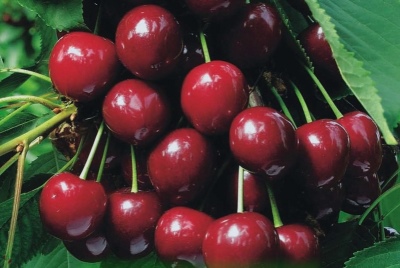
- Fruit shape: wide heart
- Authors: Canada
- Appeared when crossing: Van x Sam
- Name synonyms: Sammit
- Growth type: vigorous
- Appointment: universal
- Yield: high
- Crown: spherical, powerful
- Fruit size: large
- Fruit weight, g: 10
Cherry Summit is a popular variety that attracts attention with excellent fruit characteristics and high yields. It is worth figuring out what attracts the tree to gardeners.
Breeding history
Breeders from Canada were engaged in breeding the variety. The scientists were pleased with the result, as they managed to obtain a mid-season tree that forms large berries with a pleasant taste and aroma.
Description of the variety
The medium-ripening variety stands out for its high growth. Specifications:
crown shape - conical;
branches - flexible, dark brown;
leaves are medium in size, dark green in color.
In early April, the tree opens up pale pink flowers.
Fruit characteristics
The variety pleases gardeners with large fruits, the average size of which reaches 35 mm in diameter, weight - 10 g. Characteristics:
form - wide-heart;
skin color - from red to dark red;
the pulp is dense, bright red in color.
The stone of the cherry Summit is round, small, easily separated from the juicy pulp.
Taste qualities
The variety has a dessert, wine taste with a slight sourness. Berries are great for fresh consumption. And also the properties of the fruits allow them to be used for canning.
Ripening and fruiting
The first flowers appear closer to the beginning of April. Berries are formed in the second half of July and ripen not simultaneously, but in 2 or 3 waves. Therefore, cherries make it possible to re-harvest.

Yield
The plant shows excellent yields. On average, it is possible to collect from 1 hectare to 80 centners of berries per year. With careful care, 1 hectare is capable of producing up to 140 quintals of fruits.
Self-fertility and the need for pollinators
Summit is a self-fertile variety, so pollinators are required nearby, thanks to which the tree can form fruits. The best option would be to plant nearby varieties of Rechitsa or Poetzia.
Growing and care
The correct choice of a seedling and a place for growing a crop has a significant value on the yield indicator. Basic recommendations.
When buying seedlings, preference should be given to young plants without defects in the form of outgrowths, scratches or cracks. The bark should be smooth and shiny and the root system well developed.
Cherry Summit prefers to grow on small slopes or flat areas where there is no stagnation of moisture. Otherwise, if drainage is not provided, the plant will quickly rot.
The acidity index of the soil should not exceed 4%. Therefore, before planting, it is worth conducting soil studies.
The site must be well lit and protected from winds and strong drafts.
The landing time is determined by the climatic features of the region. In warm regions, you can plant cherries in the fall, in the northern regions it is better to adhere to the standard scheme, and choose spring for planting.
Algorithm for planting cherries Summit.
First, prepare the site. 10 days before planting cherries, dig holes up to 0.4 meters deep and 0.5 meters wide.At the bottom of each hole, a layer of mullein or humus is laid out for additional feeding of the soil.
Before planting a seedling, the soil is loosened, saturating it with oxygen, and also weeded to remove pests.
The seedling is planted so that the neck is 5 cm above ground level. After planting, the roots are carefully covered and tamped. Water the plant only after a week.
Timely caring for the plant will help to achieve a bountiful harvest.
Watering. Irrigation should be carried out every 3-4 days in the summer, adding 1-2 buckets of warm water to the soil. When cherries reach 4 years of age, watering can be reduced to 3 times per season.
Top dressing. Fertilizing the soil is necessary at the beginning of the season, during flowering, fruiting. And also it is worth feeding the plant before frost. Organic compounds and superphosphate solutions are used as fertilizers.
Whitewashing and trimming. Seasonal treatments that help strengthen the tree's immunity and improve the quality of the harvest. Pruning in the early years is necessary for the formation of the crown, after which it is carried out to remove old or dry branches.
Taking into account the recommendations will allow you to get a high-quality harvest.




Disease and pest resistance
The tree is famous for its strong immunity. Sweet cherry is not affected by coccomycosis, bacterial cancer, but it is not resistant to pests. Therefore, gardeners recommend performing preventive treatment before the tree begins to bloom.

Requirements for soil and climatic conditions
The tree is characterized by increased winter hardiness and is able to endure even the most severe winters without additional shelter. The variety grows actively even under unfavorable conditions, forming a lush crown. Cherry easily tolerates droughts.
































































